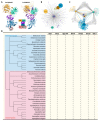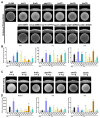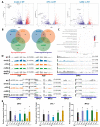The COMPASS Complex Regulates Fungal Development and Virulence through Histone Crosstalk in the Fungal Pathogen Cryptococcus neoformans
- PMID: 37367608
- PMCID: PMC10301970
- DOI: 10.3390/jof9060672
The COMPASS Complex Regulates Fungal Development and Virulence through Histone Crosstalk in the Fungal Pathogen Cryptococcus neoformans
Abstract
The Complex of Proteins Associated with Set1 (COMPASS) methylates lysine K4 on histone H3 (H3K4) and is conserved from yeast to humans. Its subunits and regulatory roles in the meningitis-causing fungal pathogen Cryptococcus neoformans remain unknown. Here we identified the core subunits of the COMPASS complex in C. neoformans and C. deneoformans and confirmed their conserved roles in H3K4 methylation. Through AlphaFold modeling, we found that Set1, Bre2, Swd1, and Swd3 form the catalytic core of the COMPASS complex and regulate the cryptococcal yeast-to-hypha transition, thermal tolerance, and virulence. The COMPASS complex-mediated histone H3K4 methylation requires H2B mono-ubiquitination by Rad6/Bre1 and the Paf1 complex in order to activate the expression of genes specific for the yeast-to-hypha transition in C. deneoformans. Taken together, our findings demonstrate that putative COMPASS subunits function as a unified complex, contributing to cryptococcal development and virulence.
Keywords: COMPASS; Cryptococcus neoformans; H2B ubiquitination; H3K4 methylation; virulence; yeast-to-hypha transition.
Conflict of interest statement
The authors declare no conflict of interest.
Figures






Similar articles
-
Distinct requirements for the COMPASS core subunits Set1, Swd1, and Swd3 during meiosis in the budding yeast Saccharomyces cerevisiae.G3 (Bethesda). 2021 Oct 19;11(11):jkab283. doi: 10.1093/g3journal/jkab283. G3 (Bethesda). 2021. PMID: 34849786 Free PMC article.
-
Charge-based interaction conserved within histone H3 lysine 4 (H3K4) methyltransferase complexes is needed for protein stability, histone methylation, and gene expression.J Biol Chem. 2012 Jan 20;287(4):2652-65. doi: 10.1074/jbc.M111.280867. Epub 2011 Dec 6. J Biol Chem. 2012. PMID: 22147691 Free PMC article.
-
Histone crosstalk between H2B monoubiquitination and H3 methylation mediated by COMPASS.Cell. 2007 Dec 14;131(6):1084-96. doi: 10.1016/j.cell.2007.09.046. Cell. 2007. PMID: 18083099
-
The COMPASS family of histone H3K4 methylases: mechanisms of regulation in development and disease pathogenesis.Annu Rev Biochem. 2012;81:65-95. doi: 10.1146/annurev-biochem-051710-134100. Annu Rev Biochem. 2012. PMID: 22663077 Free PMC article. Review.
-
Histone H2B ubiquitination and beyond: Regulation of nucleosome stability, chromatin dynamics and the trans-histone H3 methylation.Epigenetics. 2010 Aug 16;5(6):460-8. doi: 10.4161/epi.5.6.12314. Epub 2010 Aug 16. Epigenetics. 2010. PMID: 20523115 Free PMC article. Review.
Cited by
-
H3K4 Methylation and Demethylation in Fungal Pathogens: The Epigenetic Toolbox for Survival and Adaptation in the Host.Pathogens. 2024 Dec 9;13(12):1080. doi: 10.3390/pathogens13121080. Pathogens. 2024. PMID: 39770340 Free PMC article. Review.
-
Histone acetyltransferase Gcn5-mediated histone H3 acetylation facilitates cryptococcal morphogenesis and sexual reproduction.mSphere. 2023 Dec 20;8(6):e0029923. doi: 10.1128/msphere.00299-23. Epub 2023 Oct 18. mSphere. 2023. PMID: 37850793 Free PMC article.
-
Essential roles of Rad6 in conidial property, stress tolerance, and pathogenicity of Beauveria bassiana.Virulence. 2024 Dec;15(1):2362748. doi: 10.1080/21505594.2024.2362748. Epub 2024 Jun 11. Virulence. 2024. PMID: 38860453 Free PMC article.
-
Epigenetic Regulation of Fungal Secondary Metabolism.J Fungi (Basel). 2024 Sep 13;10(9):648. doi: 10.3390/jof10090648. J Fungi (Basel). 2024. PMID: 39330408 Free PMC article. Review.
-
Rtf1 HMD domain facilitates global histone H2B monoubiquitination and regulates morphogenesis and virulence in the meningitis-causing pathogen Cryptococcus neoformans.Elife. 2025 May 12;13:RP99229. doi: 10.7554/eLife.99229. Elife. 2025. PMID: 40353352 Free PMC article.
References
-
- Schneider J., Wood A., Lee J.-S., Schuster R., Dueker J., Maguire C., Swanson S.K., Florens L., Washburn M., Shilatifard A. Molecular Regulation of Histone H3 Trimethylation by COMPASS and the Regulation of Gene Expression. Mol. Cell. 2005;19:849–856. doi: 10.1016/j.molcel.2005.07.024. - DOI - PubMed
Grants and funding
LinkOut - more resources
Full Text Sources

